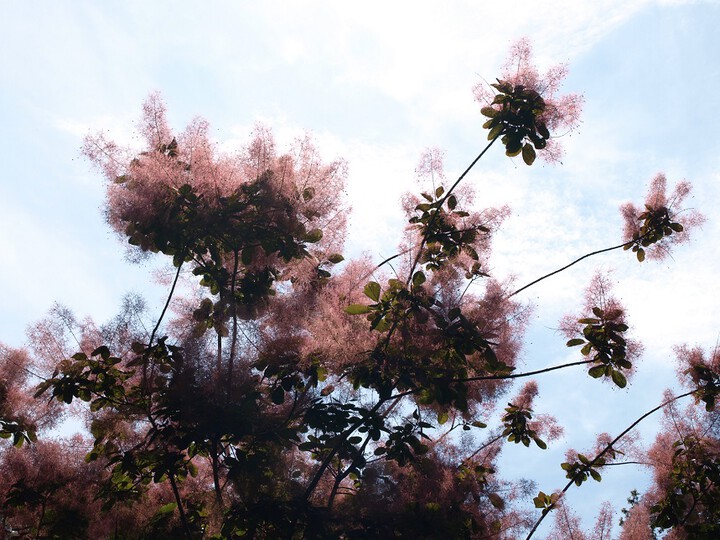Crazy for Cotinus coggygria? We've got you covered.

Winners for their vivid foliage, autumnal purple hue, and clusters of flowers that resemble plumes of smoke, smoke bush (Cotinus coggygria) is a favorite bloom, both in the garden and in our vases. But smoke bush isn't actually a flower at all. Smoke bush, also known as smoke tree, is a deciduous shrub; the multi-stemmed plant can actually be grown as a larger shrub or even smaller tree. It's a popular garden plant in drier, more arid regions of the United States, since it's drought tolerant once established (water conservation won't impact this hardy option). A
head, everything you need to know about smoke bush, from distinguishing (and caring for!) its many varietals to using them in your own floral arrangements.
There are many popular varieties of smoke bush.
You'll see four main types of smoke bush on the market. "Golden Spirit," one of the most common, actually isn't purple (the plant's mainstay shade). Also known as "Ancot," this iteration has lime green foliage in the summer and turns orange and red come fall—over time, it grows to 10 feet tall and six feet wide. "Grace" is even larger: It reaches 15 feet tall and wide, and boasts burgundy-purple foliage in the spring and summer months before transitioning to an orange-red in autumn.
Probably the most common, "Royal Purple" has red-purple foliage that turns scarlet in the fall; another large-scale plant, the variety grows 15 feet tall and 12 feet wide. For a touch of bronze, "Nordine" is a great choice. The burgundy-bronze plumes change to brilliant red and orange during the colder months and is similar to "Grace" in size. No matter the variety, however, you can count on these beauties for oval leaves, fall colorways, and frothy-pink clusters of summer blooms.
They need a lot of light.
Be sure to plant a smoke bush in a spot that gets full sun—at least six hours a day. While they're highly tolerant of different types of soil, it needs to be well draining. If your soil has a high clay content or is compacted, add plenty of compost or consider positioning them atop a raised mount. When it's time to plant, dig a hole twice the size of the root ball to give the roots plenty of space to expand—then water everything well. Keep the plant from drying out during its first growing season—remember, it must be properly established before it can begin exhibiting its drought-tolerant abilities.
Pruning isn't mandatory.
Smoke bush is an easy plant to grow and doesn't require much in the way of maintenance, pruning included (consider it optional). If you do decide to give yours a good pruning (it's best to do so in the spring) to control their size and shape, rest assured that it will bounce right back—but you won't see its smoke-inspired blooms until the following season. A springtime layer of compost topped by some mulch is plenty of nourishment for a smoke tree—no need for heavy applications of fertilizer.
They're a florist favorite.
And for good reason: Smoke bush looks lovely in arrangements all year round. Making your own? If your plumes are on the larger side, consider creating an oversized, exuberant arrangement (it will look as if a cloud has settled right there in your room). Working in a smaller space? Little buds will add plenty of whimsy and levity to petite displays. Beyond its plumes, smoke bush's waxy oval foliage also makes for great filler—the possibilities really are endless.